Pharmacokinetics study of FT-FAPI, a novel multi-nuclide label-able FAP targeting tracer, in mice and healthy volunteers.
IF 7.6
1区 医学
Q1 RADIOLOGY, NUCLEAR MEDICINE & MEDICAL IMAGING
European Journal of Nuclear Medicine and Molecular Imaging
Pub Date : 2025-05-27
DOI:10.1007/s00259-025-07362-4
引用次数: 0
Abstract
PURPOSE Fibroblast activation protein (FAP) has emerged as one of the most promising theranostic targets. FT-FAPI, a potential FAP-targeted probe with enhanced tumor-targeting ability using an organotrifluoroborate linker, was verified for the biological effect in cell and animal experiments in previous work. However, the differences in pharmacokinetic profiles, biodistribution and dosimetry of FT-FAPI under multiple nuclides labeling in animals and humans is unclear. In this study, we sought to explore the discrepancies in the performance of FT-FAPI after labeling with different radioisotopes and to compare 68Ga-FT-FAPI with 68Ga-FAPI-04 in healthy volunteers. METHODS Preparation and quality control of 18F-/68Ga-/177Lu-FT-FAPI injections were conducted. Biodistribution studies were performed in mice and pharmacokinetic analysis were performed using blood samples. 18F-FT-FAPI and 68Ga-FT-FAPI were initially tested in normal volunteers, respectively. Further, 68Ga-FT-FAPI was scanned at multiple time points for 1 h dynamic, 2 h and 3 h static imaging, and compared with 68Ga-FAPI-04 to clarify the distribution patterns and excretion parameters. Radiation dosimetry was estimated based on the uptake of the probes in organs of mice or humans, respectively. RESULTS 18F-/68Ga-/177Lu-FT-FAPI showed high safety and tolerability in mice or humans. The pharmacokinetic characteristics of FT-FAPI in mice and humans best fit a two-compartment model. In mice, the results of biodistribution showed that the clearance half-life (T1/2β) of FT-FAPI varied with different labeled radionuclides, with 68Ga-FT-FAPI having the shortest T1/2β of 26.1 min. In HT-1080-FAP tumor-bearing mice, 177Lu-FT-FAPI showed higher tumor uptake and longer retention time than 177Lu-FAPI-04, which implies a higher radiation dose in the tumor. In healthy volunteers, both 18F-FAPI-04 and 68Ga-FT-FAPI were metabolized by the kidneys and excreted through the urinary system. The uptake of 68Ga-FT-FAPI in most normal tissues was similar to that of 68Ga-FAPI-04, being higher only in the sublingual gland, thyroid gland and pancreas. 68Ga-FT-FAPI had similar T1/2β (75.0 min vs. 77.2 min) and a slightly higher effective dose (ED) (12.4 ± 1.51 µSv·MBq-1 vs. 9.99 ± 1.85 µSv·MBq-1) compared to 68Ga-FAPI-04. Compared to 68Ga-FT-FAPI, 18F-FT-FAPI has slightly higher liver and bone uptake, especially in the delayed time points. CONCLUSION The pharmacokinetics of FT-FPAI varies depending on the labeled nuclide. Compared to 177Lu-FAPI-04, 177Lu-FT-FAPI showed higher tumor uptake and longer retention time. In healthy volunteers, 68Ga-FT-FAPI had lower renal uptake and higher sublingual gland, thyroid gland and pancreas uptake at 1 h p.i. than that of 68Ga-FAPI-04, with no significant differences in other organs. Further optimization will be conducted for the radiolabeling process of 18F-FT-FAPI to evaluate its diagnostic efficacy.一种新型多核素标记FAP靶向示踪剂FT-FAPI在小鼠和健康志愿者体内的药代动力学研究
目的成纤维细胞活化蛋白(FAP)已成为最有希望的治疗靶点之一。FT-FAPI是一种潜在的fap靶向探针,利用有机三氟硼酸盐连接体增强了肿瘤靶向能力,在之前的研究中已经在细胞和动物实验中验证了其生物学效应。然而,FT-FAPI在多种核素标记下在动物和人体内的药代动力学特征、生物分布和剂量学上的差异尚不清楚。在本研究中,我们试图探索不同放射性同位素标记后FT-FAPI性能的差异,并在健康志愿者中比较68Ga-FT-FAPI与68Ga-FAPI-04。方法制备18F-/68Ga-/177Lu-FT-FAPI注射液并进行质量控制。在小鼠中进行了生物分布研究,并使用血液样本进行了药代动力学分析。18F-FT-FAPI和68Ga-FT-FAPI分别在正常志愿者中进行初始测试。进一步对68Ga-FT-FAPI在多个时间点进行1 h动态、2 h和3 h静态成像扫描,并与68Ga-FAPI-04进行比较,明确其分布规律和排泄参数。根据探针在小鼠或人类器官中的吸收情况分别估计辐射剂量。结果18f -/68Ga-/177Lu-FT-FAPI在小鼠和人体内均具有较高的安全性和耐受性。FT-FAPI在小鼠和人体内的药代动力学特征最适合双室模型。在小鼠体内的生物分布结果显示,FT-FAPI的清除半衰期(T1/2β)随标记放射性核素的不同而不同,68Ga-FT-FAPI的T1/2β最短,为26.1 min。在HT-1080-FAP荷瘤小鼠中,177Lu-FT-FAPI比177Lu-FAPI-04表现出更高的肿瘤摄取和更长的滞留时间,表明其在肿瘤中的辐射剂量更高。在健康志愿者中,18F-FAPI-04和68Ga-FT-FAPI均由肾脏代谢并通过泌尿系统排出。68Ga-FT-FAPI在大多数正常组织中的摄取与68Ga-FAPI-04相似,仅在舌下腺、甲状腺和胰腺中较高。与68Ga-FAPI-04相比,68Ga-FT-FAPI具有相似的T1/2β (75.0 min vs. 77.2 min)和更高的有效剂量(ED)(12.4±1.51µSv·MBq-1 vs. 9.99±1.85µSv·MBq-1)。与68Ga-FT-FAPI相比,18F-FT-FAPI的肝脏和骨骼摄取略高,特别是在延迟时间点。结论FT-FPAI的药代动力学随核素的不同而不同。与177Lu-FAPI-04相比,177Lu-FT-FAPI具有更高的肿瘤摄取和更长的滞留时间。在健康志愿者中,68Ga-FT-FAPI与68Ga-FAPI-04相比,每小时1 h时肾脏摄取较低,舌下腺、甲状腺和胰腺摄取较高,其他器官无显著差异。我们将对18F-FT-FAPI的放射性标记工艺进行进一步优化,以评估其诊断效果。
本文章由计算机程序翻译,如有差异,请以英文原文为准。
求助全文
约1分钟内获得全文
求助全文
来源期刊
CiteScore
15.60
自引率
9.90%
发文量
392
审稿时长
3 months
期刊介绍:
The European Journal of Nuclear Medicine and Molecular Imaging serves as a platform for the exchange of clinical and scientific information within nuclear medicine and related professions. It welcomes international submissions from professionals involved in the functional, metabolic, and molecular investigation of diseases. The journal's coverage spans physics, dosimetry, radiation biology, radiochemistry, and pharmacy, providing high-quality peer review by experts in the field. Known for highly cited and downloaded articles, it ensures global visibility for research work and is part of the EJNMMI journal family.

 求助内容:
求助内容: 应助结果提醒方式:
应助结果提醒方式:


